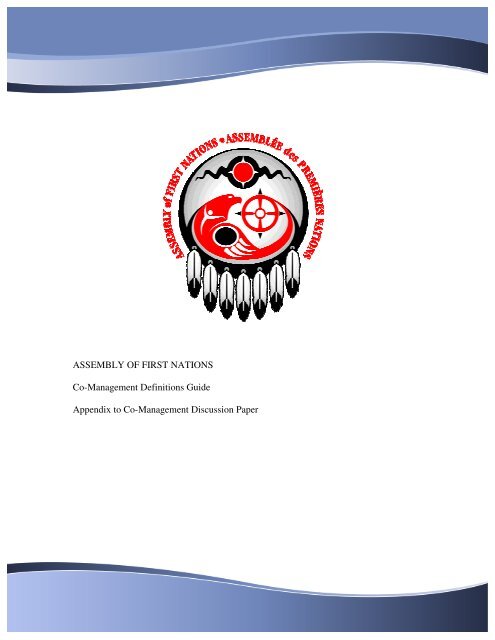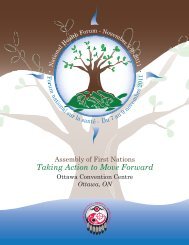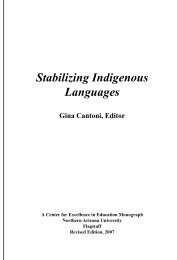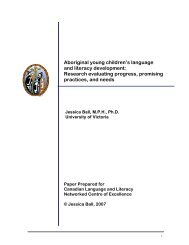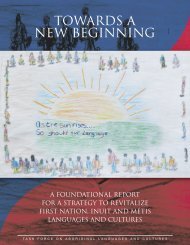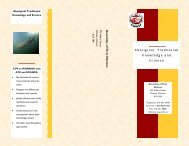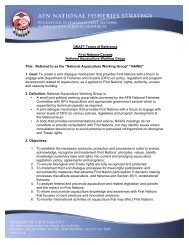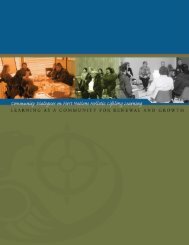ASSEMBLY OF FIRST NATIONS Co-Management Definitions Guide ...
ASSEMBLY OF FIRST NATIONS Co-Management Definitions Guide ...
ASSEMBLY OF FIRST NATIONS Co-Management Definitions Guide ...
Create successful ePaper yourself
Turn your PDF publications into a flip-book with our unique Google optimized e-Paper software.
<strong>ASSEMBLY</strong> <strong>OF</strong> <strong>FIRST</strong> <strong>NATIONS</strong><br />
<strong>Co</strong>-<strong>Management</strong> <strong>Definitions</strong> <strong>Guide</strong><br />
Appendix to <strong>Co</strong>-<strong>Management</strong> Discussion Paper
JOINT-MANAGEMENT - 2 -<br />
Introduction P.3<br />
Kearney et al. (2007) P.4<br />
Pomeroy and Berkes (1997) P.5<br />
Rusnak (1997) P.7<br />
Government of Canada P.9<br />
Suggested Readings P.10
JOINT-MANAGEMENT - 3 -<br />
Introduction<br />
The following guide highlights several articles considered by the Assembly of First<br />
Nations in the creation of its 2010-11 <strong>Co</strong>-<strong>Management</strong> Survey and <strong>Co</strong>-<strong>Management</strong><br />
Discussion Paper. This guide briefly summarizes several different interpretations of the<br />
term “co-management” as presented by academics and the Government of Canada. The<br />
definitions presented within do not represent any views or positions advanced by the<br />
Assembly of First Nations and are meant for discussion purposes only. Citations have<br />
been provided along with a list of suggested readings in order to further conversations<br />
regarding co-management between the Department of Fisheries and Oceans and the<br />
Assembly of First Nations.
JOINT-MANAGEMENT - 4 -<br />
1) John Kearney, Fikret Berkes, Anthony Charles, Evelyn Pinkerton, Melanie<br />
Wiber, “The Role of Participatory Governance and <strong>Co</strong>mmunity-Based<br />
<strong>Management</strong> in Integrated <strong>Co</strong>astal and Ocean <strong>Management</strong> in Canada,”<br />
<strong>Co</strong>astal <strong>Management</strong>, 35:5 (2007): 79-104<br />
Term: <strong>Co</strong>mmunity-Based <strong>Management</strong><br />
Definition: …“involves the people living closest to the resource in the design,<br />
implementation, and monitoring of management measures” (p. 80)<br />
Summary: [FROM ABSTRACT] The purpose of this paper is discuss the role of<br />
government, primarily national government, in fisheries co-management. This paper<br />
investigates the critical role of decentralization in a strategy of co-management using a<br />
number of international cases. The experiences of co-management and decentralization<br />
provide for a number of policy implications to be drawn concerning the role of<br />
government. Pomeroy and Berkes suggest that co-management in Canada works on a<br />
“devolution” model between government and First Nations, primarily because land<br />
claims and treaties provide legally defined relationships between the two parties. The<br />
authors state that co-management regimes must be taken on a case-by-case basis.
JOINT-MANAGEMENT - 5 -<br />
2) Robert S. Pomeroy, Fikret Berkes, “Two to Tango: the role of government in<br />
fisheries co-management,” Marine Policy 21:5 (1997): 465-480<br />
Term: <strong>Co</strong>mmunity-Based <strong>Co</strong>stal Resource <strong>Management</strong> (CBCRM)<br />
Definition: …“the sharing of responsibility and authority between the government and<br />
the community of local fishers to manage a fishery”<br />
Summary: [FROM ABSTRACT] The purpose of this paper is discuss the role of<br />
government, primarily national government, in fisheries co-management. This paper<br />
investigates the critical role of decentralization in a strategy of co-management using a<br />
number of international cases. The experiences of co-management and decentralization<br />
provide for a number of policy implications to be drawn concerning the role of<br />
government. Pomeroy and Berkes suggest that co-management in Canada works on a<br />
“devolution” model between government and First Nations, primarily because land<br />
claims and treaties provide legally defined relationships between the two parties. The<br />
authors state that co-management regimes must be taken on a case-by-case basis.<br />
<strong>Co</strong>-<strong>Management</strong> Model:<br />
The level of co-management depends on the ability for a community to control its own<br />
resources, the degree possible within the legal system, the ability for fishers to coordinate<br />
and organize. <strong>Co</strong>-mgmt assumes an equal access to information, with community having<br />
traditional knowledge and government having access to academic knowledge. For a comanagement<br />
regime to be successful, government must have a legal regime in place for<br />
support. In Canada, true co-management can only exist between government and First<br />
Nations because land claim agreements provide legally defined rights. Government must<br />
allow fisher groups to freely meet and organize and government must recognize<br />
legitimacy of community decisions. <strong>Co</strong>-management democratizes and empowers.<br />
Legal – legal rights and authorities for devolution, authority legally delegated to<br />
communities<br />
Joint-action community/government at local level – data gathering, logistical decisions<br />
(e.g., who can harvest/where), allocation decisions, protection of resources from<br />
environmental damage, enforcement, enhancement of long-term planning, more inclusion<br />
in decision making. (Pinkerton, 1989)
JOINT-MANAGEMENT - 6 -<br />
Government<br />
<strong>Co</strong>ntrol<br />
<strong>Co</strong>mmunity<br />
<strong>Co</strong>ntrol<br />
Degree of<br />
Decentralization<br />
Deconcentration<br />
Delegation<br />
Devolution<br />
Privatization<br />
Form Definition Example<br />
Internal<br />
Policy<br />
Based<br />
Policy<br />
Based<br />
Legal<br />
Based<br />
Policy<br />
Based<br />
Power/authority is<br />
transferred from a central<br />
national authority to<br />
regional, district and field<br />
offices of the same<br />
national authority. Also<br />
known as administrative<br />
decentralization.<br />
Some authority is passed<br />
to local officials but the<br />
central national authority<br />
retains the right to<br />
overturn local decisions<br />
and can reclaim power at<br />
any time<br />
Power and<br />
responsibility for<br />
specified functions is<br />
transferred to the local<br />
level without reference<br />
back to the national<br />
authority. The transfer<br />
is legislative, not policy,<br />
and is done<br />
geographically instead<br />
of sectoral.<br />
Responsibility for some<br />
government functions are<br />
transferred to NGO,<br />
voluntary organizations,<br />
community organizations,<br />
or private companies.<br />
Magnuson Act (U.S)<br />
Lake<br />
Cariba/CAMPFIRE<br />
(Zimbabwe)<br />
Atlantic Canada<br />
“Advisory Model”<br />
James Bay and<br />
Northern Quebec<br />
Agreement<br />
Inuvialuit<br />
Agreement<br />
Nunavut Agreement<br />
Bangladesh and<br />
Dutch ITQ systems<br />
Case Studies Listing: Magnuson Act, Lake Cariba, CAMPFIRE, Atlantic Canada<br />
Advisory Model, James Bay and Northern Quebec Agreement, Inuvialuit Final<br />
Agreement, Nunavut Agreement, Dutch ITQ System, Bangladesh ITQ System<br />
Quote: The decision on what fisheries management functions should be handled at which<br />
level are best handled jointly by local-level organizations and national government<br />
fisheries agencies, and they will be location specific. The decision will be based on the<br />
capabilities of local-level organizations to handle certain management functions and the<br />
locus of user participation. (478)
JOINT-MANAGEMENT - 7 -<br />
3) Gerret Rusnak, “<strong>Co</strong>-<strong>Management</strong> of Natural Resource in Canada: A Review<br />
of <strong>Co</strong>ncepts and Case Studies,” Rural Poverty and Environment Working<br />
Paper Series (Ottawa: International Development Research Centre, 1997)<br />
Term: <strong>Co</strong>-management<br />
Definition: “This relationship involves a change from a system of centralized authority<br />
and top-down decisions, to a system which integrates local and state level management in<br />
arrangements of shared authority, or at least shared decision-making”<br />
Summary: Rusnak provides an overview of co-management regimes in Canada,<br />
touching of the concept of co-management, examples, specific agreements, participation,<br />
information and analysis, and decision making structures. Rusnak argues that “the history<br />
of political and legal struggles for Aboriginal title and land claims” (4) is a large part for<br />
current co-management regimes, and that power sharing structures are usually borne out<br />
of crisis resulting in unclear/overlapping jurisdiction or resource conflict stemming from<br />
depletion.<br />
<strong>Co</strong>-<strong>Management</strong> Model: Rusnak provides no single model ideal but touches on aspects<br />
that may be included in a regime, including:<br />
• ATK use/collection/authorization<br />
• <strong>Co</strong>-management boards<br />
• Quota restrictions<br />
• Quota allocations<br />
• Designing, administering, monitoring research programs<br />
• Regulating commercial activities<br />
• Enforcing regulations<br />
• Legislation/policy analysis/recommendations<br />
• Developing/implementing conservation plans<br />
• Assessing resource development proposals<br />
• <strong>Co</strong>operating with other co-management bodies<br />
• <strong>Co</strong>nsulting with community and harvester information<br />
• Responding to requests for information/research/action<br />
• Socioeconomic development programs<br />
• Income security<br />
• Mandatory impact assessments<br />
• Royalties<br />
• <strong>Co</strong>mpensation<br />
• Joint coordinating committees<br />
• Equally-shared decision making authority<br />
• Authority to make recommendations for action
JOINT-MANAGEMENT - 8 -<br />
Case Study Listing: James Bay and Northern Quebec Agreement, Inuvialuit Final<br />
Agreement, Nunavut Land Claims Agreement, Gwich’in and Dene Sahtu Nations,<br />
Barrier Lake Trilateral Agreement, Beverly-Qaminirjuaq Caribou <strong>Management</strong> Board<br />
Quote: “<strong>Co</strong>-management is an ideal management system which does not actually exist in<br />
practice but is aspired to and incrementally approached.” (3)<br />
“While co-management arrangements offer potential to improve the participation of<br />
indigenous peoples in resource management, they run the risk of having little impact on<br />
the tradition of top-down state management since many of their decisions are merely<br />
passed on to government ministers as recommendations” (21)
JOINT-MANAGEMENT - 9 -<br />
6) Government of Canada <strong>Definitions</strong><br />
Department of Fisheries and Oceans<br />
“The sharing of authority and responsibility for fisheries management, and of<br />
accountability for results, between DFO and resource users” (The <strong>Management</strong> of<br />
Fisheries On Canada’s Atlantic <strong>Co</strong>ast: A Discussion Paper on Policy Direction and<br />
Principles, 2001, Ottawa, ON: Atlantic Fisheries Policy Review)<br />
“<strong>Co</strong>-management is a process that brings together local hunters and fishermen,<br />
government agencies and public management boards to share management responsibility<br />
for fishery resources.” (Fresh Water Institute Factsheet #5: <strong>Co</strong>-<strong>Management</strong> of Fisheries<br />
Resources, 2001)<br />
“<strong>Co</strong>operative management, joint management, and collaborative management are all<br />
terms synonymous with co-management. These terms are used to define an institutional<br />
arrangement in which responsibility for resource management, conservation, and/or<br />
economic development is shared between governments and user groups; management<br />
systems in which users and other interests take an active part in designing,<br />
implementing, and enforcing management regulations; a sharing of decision making<br />
between government agencies and community-based stakeholders; management<br />
decisions (policy) based on shared information, on consultation with stakeholders, and<br />
on their participation: the integration of local-level and state-level systems; and/or<br />
institutional arrangements in which governments and other parties, such as Aboriginal<br />
entities, local community groups, or industry sectors enter into formal agreements<br />
specifying their respective rights, powers, and obligations with reference to, for example,<br />
environmental conservation and resource development”<br />
Canada’s Oceans Strategy (2002), referencing the definition reached at the 1998 National<br />
Round Table on Environment and the Economy (Sustainable Strategies for Oceans: A<br />
<strong>Co</strong>-<strong>Management</strong> <strong>Guide</strong>, 1998 NRTEE Ottawa).<br />
Royal <strong>Co</strong>mmission on Aboriginal Peoples (1997)<br />
“<strong>Co</strong>-management has come to mean institutional arrangements whereby governments<br />
and Aboriginal entities (and sometimes other parties) enter into formal agreements<br />
specifying their respective rights, powers and obligations with reference to the<br />
management and allocation of resources in a particular area of crown lands and waters.”
JOINT-MANAGEMENT - 10 -<br />
Suggested Readings:<br />
Derek Armitage, Fikret Berkes, and Nancy Doubleday, Adaptive <strong>Co</strong>-management:<br />
<strong>Co</strong>llaboration, Learning, and Multi-level Governance (Vancouver, BC: UBC Press,<br />
2007).<br />
Fikret Berkes, “Rethinking <strong>Co</strong>mmunity-Based <strong>Co</strong>nservation,” <strong>Co</strong>nservation Biology,<br />
18:13 (2003): 621-630.<br />
Tara C. Goetze, “Sharing the Canadian Experience with <strong>Co</strong>-<strong>Management</strong>: Ideas,<br />
Examples and Lessons for <strong>Co</strong>mmunities in Developing Areas,” Rural Poverty and the<br />
Environment Working Paper Series, 15 (2004). Ottawa: IDRC.<br />
Evelyn Pinkerton, Robyn Heaslip, Jennifer Silver, and Kira Furman, “Finding ‘Space’ for<br />
<strong>Co</strong>-<strong>Management</strong> of Forests within the Neo-Liberal Paradigm: Rights, Strategies and<br />
Tools for Asserting a Local Agenda,” Human Ecology, 36 (2008): 343-355.<br />
Various materials providing First Nation perspectives on co-management are available<br />
from the British <strong>Co</strong>lumbia First Nations Fisheries <strong>Co</strong>uncil:<br />
http://www.fnfisheriescouncil.ca/index.php/mission-a-work-of-council/workinggroups/co-management-working-group


